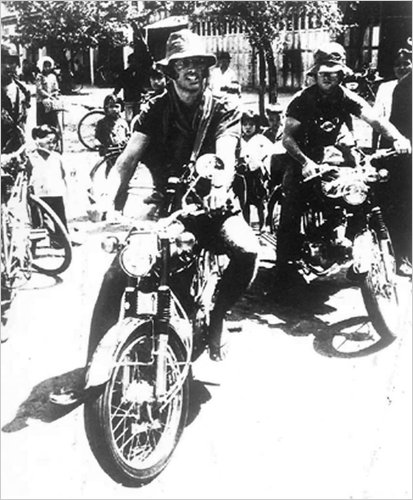On an unknown date thought to be approximately June of 1971, American photojournalists Sean Flynn and Dana Stone were executed by Communist captors in Southeast Asia.
Flynn is the big name of the pair,* literally: a former actor, he wasn’t in like his superstar father Errol Flynn. After trading on his prestigious name for a few silver screen credits, Sean grew bored of Hollywood and pivoted into a career in wanderlust — trying his hand as a safari guide and a singer before washing up in Vietnam where the action was in January 1966.
He made his name there as a man who would find a way to snatch an indelible image out of war’s hurricane, even at the risk of his own life.

One of Flynn’s photos: A captured Viet Cong being tortured. (1966)
On April 6, 1970, Flynn and fellow risk-seeking photojournalist Dana Stone hopped on rented motorbikes bound for the front lines in Cambodia. It was a last mission born of their characteristic bravado — all but bursting out of the frame astride their crotch rockets in the last photo that would become their epitaph. They were never seen again; having apparently been detained at a Viet Cong checkpoint, it’s thought that they ended up in the hands of Cambodian Khmer Rouge guerrillas and were held for over a year before they were slain by their jailers.

Flynn (left) and Stone mount the bikes for their lethal assignment. This is the last picture ever taken of them.
Sean’s mother, actress Lili Damita, spent years seeking definitive information about his fate, without success. Dana’s brother, John Thomas Stone, joined the army in 1971 reportedly with a similar end in mind; he was killed by friendly fire in Afghanistan in 2006. The prevailing conclusion about their fate arrives via the investigation of their colleague and friend, Australian journalist Tim Page — a man for whom memorializing the journalists who lost their lives during the Vietnam War has been a lifelong mission.
Though Flynn’s and Stone’s guts are undeniable, not everyone appreciated their methods. “Dana Stone and Sean Flynn [son of the Hollywood actor, Errol Flynn] were straight out of Easy Rider, riding around on motorcycles carrying pearl-handled pistols. Cowboys, really,” said fellow photog Don McCullin. “I think they did more harm than good to our profession.”
* He’s not to be confused with present-day actor Sean Flynn — that’s our Sean Flynn’s nephew. (Sean the nephew was named for Sean the uncle.)
On this day..
- 1764: John Ives, spectator turned spectacle
- 1895: John Eisenminger, forgiven
- 1900: Guzeppi Micallef, Maltese felon
- 1730: Sally Bassett, Bermuda slave
- 1940: 32 innocent Poles
- 1962: Henry Adolph Busch, Psycho
- 1884: Charles Henry, iced in the Arctic
- 1662: Potter, bugger
- 1879: John Blan, panicked
- 1671: Stenka Razin, Cossack rebel
- 1832: Not Javert, spared by Jean Valjean
- 1997: Henry Francis Hays, whose crime cost the Klan

I first met Dana and Sean in January 1970 in Bali, and re met them in March 1970 at Hotel Le Royal in PP. I recall that Stone was almost “bookish” in manner – very unlike his close friend Sean. Sean was a risk taker: Dana on the other hand reasonably serious.
I recall playing frizzbee with Sean and Dana in front of the hotel. Dana was really quite a good athlete, surprisingly better than Sean. Both were fun, enthusiastic and adventurous young men. Good company.
There is a plaque memorialising these two men, and others, in front of the hotel – across from the university/techcollege.
The environment was very difficult and dangerous. Lon Nol was to stage a coup the following week and armoured vehicles patrolled the streets of PP.
I had heard Dana and Sean discussing a trip to the front to meet “… the little men with the red scarves”. Others more informed that me tried to talk them out of it. But, I guess it is hard to put an old head on young shoulders.
I returned to the hotel in 2014 – now the Raffles Le Royal. (I think in 1970 it was owned by Sihanouk?) It has changed a lot as separate bungalows moved and pool installed. I had a long talk with the general manager and he told me that there were “…many, many photographs of journalists from the bad times (1970s)” in the hotel archives.
For anyone performing research into these men, these archives may have interesting photographs.
I have often wondered what responsibility the news services that employed these young men had in their deaths. Is it reasonable to expect that these organisations should have assisted in some kind of risk assessment?
My, and the view of many wiser people at the hotel, was that the potential cost vs potential benefit was not worth the risk.
In 1968 while I was in the 1st Cav Division, one morning a little woman with a photographer showed up at Camp Evans. We had been attacked by rockets and mortars the night before and knocked out a lot of communication antennas. That is how I remember it so well. The woman said her name was Louise and his name was Dana. Louise went in to talk with the General Tolson and Dana went in but quickly came back outside and started to talk with me. He asked me a few question and then asked if he could take my picture. He said it would be in my hometown paper back home. Sure enough it was and the name under the picture was Louise Stone. Years went by before I ever knew who they were. Sadly Dana was never found. I’m 70 years old now and I still have that clipping from 50 years ago when I got to spend a few minutes talking with Dana Stone.